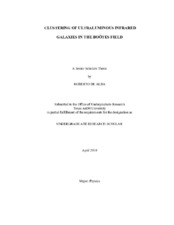| dc.description.abstract | We study the nature and clustering of infrared (IR) galaxies at z~1.5-3 in a 9 deg2 region
from the Spitzer Deep, Wide-Field Survey (SDWFS) and the MIPS (Multiband Imaging
Photometer for SIRTF) AGN (Active Galactic Nuclei) and Galaxy Evolution Survey
(MAGES), taken at the Space Infrared Telescope Facility (SITRF). Using a method
developed by Huang et al., we identify stellar-dominated IR-luminous galaxies at 1.5 < z
< 3 by selecting objects with characteristic infrared (3.6, 4.5, and 8.0 micron) flux ratios
and 24 micron flux density (S(24) hereafter) > 0.3 mJy. We compute the angular
correlation function of this sample over scales of 0.001 - 1 deg. Assuming an empirical
redshift distribution, we derive spatial correlation scale lengths, r0 = 7.65 +/- 0.9 h-1 Mpc
for S(24) > 0.3 mJy and 8.73 +/- 2.1 h-1 Mpc for S(24) > 0.5 mJy, with a possible scale
length increase at higher 24 micron flux densities. We compare our sample to IRluminous,
dust-obscured galaxies (DOGs) at this redshift selected on the basis of their
large mid-infrared to visible flux ratio, and which are known to include AGN, objects
presumably powered by supermassive black hole accretion. While the DOG sample includes objects with S(24) > 1 mJy, our IR-luminous, stellar-dominated sample contains
few bright objects, and is approximately limited to S(24) <~ 0.6 mJy; high 24-micron
brightness at z~2 requires a substantial amount of dust heated by AGN. At 0.3 mJy <
S(24) < 0.6 mJy, the clustering strength of these two samples are nearly
indistinguishable, and they are consistent with the clustering of other massive galaxies at
these redshifts. Therefore, we conclude that these objects occupy dark-matter haloes of
similar mass, on the order of 5 x 1012M, and that these massive galaxies experience IRactive
stages as a result both of star-formation and AGN activity with some duty cycle. | en |


